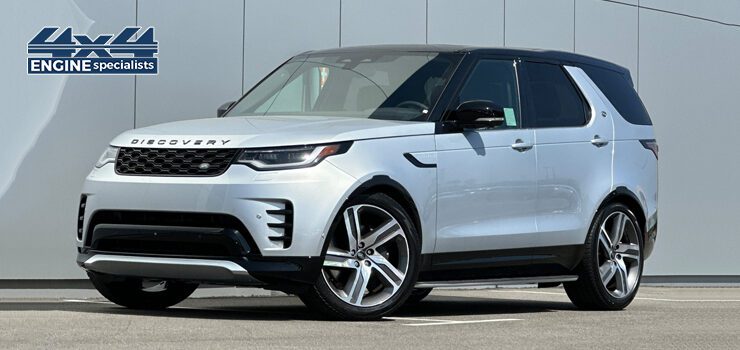The Land Rover Discovery P360 Petrol Engine is a masterpiece of power, efficiency, and advanced technology. Being an Ingenium family member of Jaguar Land Rover, it has refined performance with a touch of modern-day efficiency. This study looks into the capabilities of the P360 and its powers about the nature of power output, economy in fuel use, and the capacity to drive well on all terrains. As such, its design is compared to that of other alternatives, including the Range Rover Engine 2.0.
Land Rover Discovery P360: Summary of Specifications
The Land Rover Discovery P360 is powered by a 3.0-liter Ingenium six-cylinder petrol engine, whereby it has utilized MHEV technology. The engine pumps out a punchy 355 hp and a torque of 365 lb-ft; hence, it cuts well even in extreme conditions. It does not bother with the tag-on lag of the turbo due to the twin-scroll turbocharger added with an electronic supercharger.
Integration of the MHEV system means that all this fuel efficiency is coupled with recoveries of energy during braking and deceleration. All these are conserved in a 48-volt battery that creates an auxiliary condition during acceleration, saving both fuel and emissions. The P360 truly merges striking power and sustainability. It’s very inviting for luxury SUV buyers wanting versatility.
Performance about Acceleration and Top Speed
Probably the most attractive feature of the new Land Rover Discovery P360 Petrol Engine lies in its dramatic acceleration and top speeds. Accelerated from 0-60mph, the engine delivers the Discovery in approximately 6.2 seconds pretty respectable time for a car of its dimensions and weight. It is acceleration without jerk thanks to the smooth mutual functioning of the twin-scroll turbocharger and the MHEV system.
The 130 mph top speed makes the engine highly performance-orientated. This means the driver can move along highways and open roads with great confidence and a silky-smooth yet exciting ride. The advanced eight-speed automatic transmission further builds on the capabilities of the powerplant to provide prompt, swift, and accurate gear changes. This performance capability does fit very well when benchmarked against the likes of the Range Rover Engine 2.0, but it offers more power in high-demanding events.
Efficiency and Fuel Economy with MHEV Technology
Modern engine design could not be considered complete without efficiency, and in that view, the new Land Rover Discovery P360 knocks it out of the park. The MHEV technology engineered in this automobile boosts performance while providing good fuel economy. When subjected to normal combined driving conditions for a city and highway, it delivers some 22 mpg.
This efficiency does not compromise power, making the P360 perfect for any commuting whether on-road to the city or on-off-road. The stop/start system shut down further fuels economy as it switches off the engine when idle. Unlike the Range Rover Engine 2.0, P360 provides a margin of slightly lesser efficiency due to its bigger displacement yet makes up with better horsepower and torque.
Off-Road Capability and Terrain Adaptability
In any case, the off-road reputation of the Land Rover Discovery P360 will be heavily influenced by its engine. Torque-rich performance of the P360 is perfect for challenging terrains, from steep inclines to sloppy and muddy trails. And because Land Rover paired this engine with their Terrain Response 2 system, which enables a smooth adjustment to each surface, one can be sure of optimal traction control.
MHEV system produces low-end torque, which makes it particularly beneficial during very difficult off-road terrains. During such journeys, the vehicle needs to produce immediate power output. Whichever it may be, sand, snow, or rocky terrains, the P360 engine delivers stability and power. The Range Rover Engine 2.0 performs well when put on an off-road, but the P360’s over and above amount of torque and horsepower makes it more potent for the adventurous ones.
Enhanced Cooling and Thermal Management
An advanced cooling system is used in the Land Rover Discovery P360 Petrol Engine for performance in all weathers. The twin-scroll turbocharger makes use of highly efficient cooling systems to ensure overheating does not occur during prolonged usage or intensive driving. This is especially important in ensuring reliability does not fail during sizzling off-road running or rigorous towing applications.
The MHEV system also contributes to efficiency by making power delivery even across the drivetrain. This is further reduction of the pressure on the engine, which positively affects its lifespan. On top of this, compared to the Range Rover Engine, it’s cooling technology in the P360 is better, as it is capable of handling the more significant output and larger capacity of the engine.
Towing Capacity and Heavy Load Handling
One characteristic of the Land Rover Discovery P360 engine is its strong capacity for towing. In its capacity, this car engine can pull up to 8,200 pounds, which is a class leading in this area. This ability is rendered through the output of torque from the engine and through the advanced drivetrain system.
In heavy-duty towing operations, the MHEV system provides power built in for accelerating to ensure smoother and controlled performance; with intelligent control of the increased load by the transmission system to maintain stability and efficiency. Then again, the Range Rover Engine 2.0 is very powerful, but it only has a lower towing capacity because of its relatively smaller size and power output.
NVH Characteristics
Refinement is a must for any luxury SUV, and the Land Rover Discovery P360 Petrol Engine has been built to reduce noise, vibration, and harshness (NVH). Inline-sixes cut less vibration than a V6 configuration, by way of nature, and the MHEV system transitions smooth at acceleration and deceleration.
The acoustic insulation of the engine bay contributes towards improving cabin quieterness, even at high speeds. Thus, drives remain serene. This calm ambiance is experienced by both drivers and passengers, regardless of the engine’s performance requirement. Compared to Range Rover Engine 2.0, the P360 is also better with refinements mainly at higher RPMs due to advanced engineering and better soundproofing measures.
What are the distinctions between Range Rover Engine 2.0 and the P360?
Although it is a fantastic engine – the Land Rover Discovery P360 Petrol Engine bears the essential advantages over the 2.0 in the first of these respects, targeting the 2.0-litre one at more efficiency and compact performance, better suited to towns and light duties, while the P360 is all about power, torque, and general ‘do anything’ capability for the ultimate luxury/split of capability user.
With a bigger displacement and MHEV technology, the P360 offers better towing capacity and off-road capability besides reasonable acceleration. Yet, the Range Rover Engine 2.0 is ahead in terms of its budget-friendliness in terms of fuel consumption, which impresses eco-friendly drivers. Therefore, it is difficult to make a decision between these two engines because everything depends on a driver’s needs and priorities.


